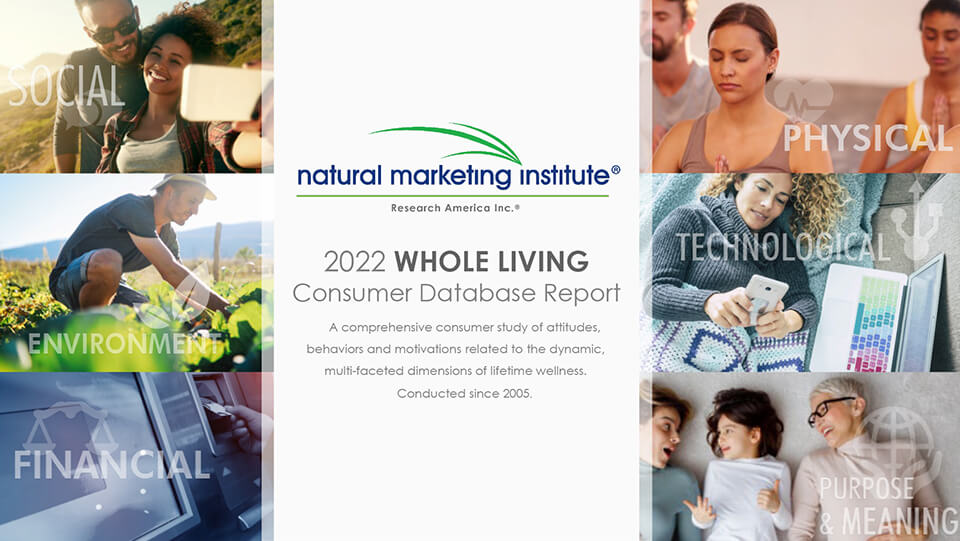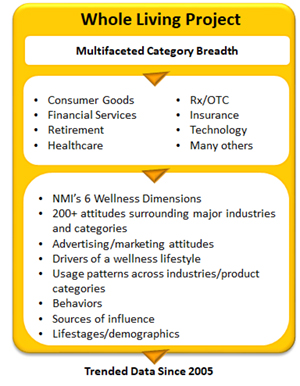New 2022 Whole Living Consumer Database Report

126 pages of the Institute’s research, study supported, providing current consumer insights with data and analysis, including charts, graphs, and illustrations!
Site License: Includes PDF, PPT with access to charts and site rights for internal network usage across one company BRAND/location.
Price: $15,000 Order Report
Introduction to the Institute’s Whole Living Project
Natural Marketing Institute® is pleased to publish its 2022 Whole Living Consumer Database Report. The Institute’s Whole Living Study is based on a new and unique way to explore health and wellness. It is based on the premise that the ongoing process of becoming aware of and making choices toward a healthy and fulfilling life. Wellness is more than being free from illness. It is a dynamic process of change and growth – an interconnected state of complete physical, mental, and social well-being – not merely the absence of health issues or medical conditions.
The construct for the study is based on 6 Dimensions of Wellness and the symbiotic relationship of emotional, physical, technological, financial, environmental, and social health. According to Steve French, COO of Research America, Inc., “in essence, as consumers become more aware that their health is dependent on the health of all dimensions, they will be prepared for their lifelong journey in pursuit of satisfaction, happiness, and balance.”
The Whole Living Consumer Study determined that while some aspects of consumers’ lives appear to be on track, others are not in a state of balance. As organizations look for insights to drive growth, they need to explore how their initiatives impact all of the dimensions.
Some example findings include:
- Almost half of all American consumers are very satisfied that their life is in a balanced state
- Only 1 in 4 are very satisfied with living an environmentally-friendly and sustainable lifestyle
- Half of consumers are often confused by the changing information on what they are supposed to do to live a healthy lifestyle
- However, over the past 10 years, significantly more consumers indicate they live a more satisfying life by having fewer material possessions
- And even in these trying times, almost three out of four consumers feel very positive and hopeful about the future
This report covers the following 6 Dimensions of Wellness and the opportunities which exist around them..
- Financial: Concern over one’s financial future is having detrimental effects across a broad spectrum of health issues, identifying opportunities for assistance tools
- Social: As consumers travel a wellness path, they become more aware of their importance in society, as well as the impact they have on multiple connection points
- Physical: The physical benefits of looking good and feeling good, most often lead to the psychological benefits of enhanced self- esteem, self-control, determination, and a sense of direction
- Technological: The more a consumer understands about their personal health, the more empowered they will be to improve upon it, and technology amplifies their understanding
- Environmental; Consumers across all generations are embracing environmental responsibility and sustainability and making the connection between planetary and personal health
- Emotional (P&M): Managing their life in personally rewarding ways and taking responsibility for their actions will help consumers to see life as an exciting, mindful, and hopeful adventure
Table of Contents
Summary Methodology
Other Database Descriptions
Definitions of Groups
Whole Living Overview
Whole Living Overview
Natural Marketing Institute's 6 Dimensions of Wellness (graphic)
Whole Living Introduction
Key Elements
Ratings of Satisfaction of Life Balance
Ratings of 6 Dimensions by Life Balance Groups
Point Allocation of Importance of 6 Dimensions
Unmet Needs among Lifestyle Factors
Unmet Needs among Generations
Derived Importance Quadrant of Lifestyle Factors
Areas of Opportunity Explanation
Fears of Aging
Reasons for Health Maintenance
Natural Marketing Institute's Whole Living Segmentation
Whole Living Segment Overview
Whole Living Segment Lifestyle Definers
Point Allocation of Importance of 6 Dimensions among Segments
Rating of Satisfaction with Life Balance by Segment
Snapshot of Segment Defining Attitudes
Segment Marketing Definitions
Demographic Summary of the Segments



Financial Dimension
Financial Dimension Definition
Snapshot of Financial Dimension Findings
Importance - Satisfaction Gaps for Financial Health
Ability to Meet Financial Obligations after Retirement
Financial Situation Since COVID-19
Repercussions of Economic Uncertainty
Uncertainty of Financial Retirement Needs
Concerns about Ability to Retire
Financial Preparedness
Health Implications of Financial Unpreparedness
Financial Implications of a Major Illness
Importance of Time vs. Money
Impact of Materialism on Life Satisfaction

Social Dimension
Social Dimension Definition
Snapshot of Social Dimension Findings
Importance - Satisfaction Gaps for Having People to Socialize With
Satisfaction with Quality of Community and Family Life
Existence of Social Support Network
Social Support Network among Satisfaction Groups
Impact of the Pandemic on Socializing
Impact of the Pandemic on Starting a Family
Pet Ownership
Perceptions of Racial Equality and Social Justice
Perceptions of Current State of Racial Equality
Perceptions of Current State of Social Justice
Interest in Corporate Support of Social Issues
Interest in Corporate Support of Social Issues by Ethnicity
Impact of Corporate Social Responsibility on Purchase
Lack of Corporate Social Responsibility on Purchase

Physical Dimension
Physical Dimension Definition
Snapshot of Physical Dimension Findings
Importance - Satisfaction of Physical Health
Personal Health Management
Ratings of Overall Health
Trended Ratings of Health by Generation
Ratings of Overall Health by Life Balance Groups
Aging Effects on Ability to Care for Oneself
Condition Management
Growth of Condition Management
Condition Management by Gender
Importance of Gut Health
Concern for Condition Prevention
Condition Management Through Nutrition
Importance - Satisfaction of Eating a Nutritious Diet
Barriers to Living Healthy
Importance - Satisfaction of Getting Enough Exercise
Cigarette and Alcohol Use
Interest in Alternative Care Options
Interest in Alternative Care Advice by Physician
Use of Telemedicine
Challenges of Caregiving
Interest in At-Home Services

Technological Dimension
Technological Dimension Definition
Snapshot of Technological Dimension Findings
Importance - Satisfaction of Understanding and Keeping Up with Technology
Interest in Health Technology by Generations
Interest in Health Technology by Ethnicity
Use of Telemedicine
Use of Telemedicine by Condition Managers
Use of Technology for Grocery Shopping
Influence of Social Media on Product Purchase

Environment Dimension
Environment Dimension Definition
Snapshot of Environment Dimension Findings
Importance - Satisfaction of Living an Environmentally-Friendly & Sustainable Lifestyle
Impact of COVID-19 on Environmental Conviction
Perceived Responsibility for Environmental Protection
Participation in Environmental Behaviors
Importance of Corporate Sustainable Initiatives
Importance of Corporate Cause Support on Purchase
Interest in Specific Corporate Initiatives
Impact of Retailer Sustainability Initiatives on Likelihood to Shop
Growth in Impact of Corporate Mindfulness on Trial and Loyalty
Connection of Personal and Planetary Health
Concern Regarding Chemical Connection to Disease
Environmental Impact of Lowered Human Activity During Pandemic
Impact of Lack of Environmental Responsibility on Purchase

Purpose & Meaning Dimension
Purpose & Meaning Dimension Definition
Snapshot of Purpose and Meaning Findings
Importance - Satisfaction of Emotional Health
Impact of the Pandemic on Emotional Well-Being
Impact of the Pandemic on Specific Emotional States
Methods of Maintaining Health
Consumers Quotes on How They Maintain Their Health
Impact of Stress on Condition Management
Stress and Energy Levels Trended
Self Descriptors by Generation
Attitudes Regarding Helping Others
Donating Behavior
Volunteerism Across Demographic Groups
Interest in Creating Change for the Better
Future Outlook by Demographic Groups
Future Outlook Across Satisfied Groups vs. Unsatisfied Groups

The Institute's Whole Living consumer segmentation identifies six distinct segments within the U.S. adult population

Definitions of Consumer Groups Within the Report
GP = General Population U.S. Adults
iGen – born 1998 to 2001 (Ages 18-23)
Millennials – born 1977 to 1997 (Ages 24-44)
Young Millennials – born 1991 to 1997 (Ages 24-30)
Older Millennials – born 1977 to 1990 (Ages 31-44)
Gen X – born 1965 to 1976 (Ages 45-56)
Boomers – born 1946 to 1964 (Ages 57-75)
Matures – born 1900- to 1945 (Ages 76+)
Heart Disease Mgr – consumers who are managing heart disease
Arthritis/Joint Mgr – consumers who are managing arthritis or joint issues
Immunity Mgr – consumers who are managing/treating cold/flu or need to boost immunity
Lack of Energy Mgr – consumers who are managing/treating lack of energy/fatigue
Sleep Mgr – consumers who are currently managing/treating sleeplessness/sleep disorders
Stress/Anxiety Mgr – consumers who are currently managing/treating stress/anxiety
Caregivers - consumers indicating they currently provide medical/managed care assistance or non-medical assistance for an aging loved one
Consumers on target with their financial retirement plan - consumers who completely/somewhat agree that they are on target with their financial plan for retirement
Consumers not on target with their financial retirement plan - consumers who completely/somewhat disagree that they are on target with their financial plan for retirement
Satisfied with financial health - Consumers indicating they are very/somewhat satisfied with their financial health
Unsatisfied with financial health - Consumers indicating they are not very/not at all satisfied with their financial health
High Sat with life balance - Score of 8-10 on a 10 pt. scale where consumers rate their satisfaction that their life is in the most balanced state that it could be
Mid Satisfaction - Score of 5-7 on a 10 pt. scale where consumers rate their satisfaction that their life is in the most balanced state that it could be
Low Sat with life balance – Score of 1-4 on a 10 pt. scale where consumers rate their satisfaction that their life is in the most balanced state that it could be
Discover Whole Living Topics Which Can Be Leveraged for Your Business – The Institute’s Whole Living Project: Summary Methodology
Scope:
- Quantitative study trended since 2005
- 2,500+ U.S. adult sample (general population)*
- Balanced to U.S. Census data across key demographics
- Statistically significant at the 95% confidence level to +/- 1.8%
- Conducted via online research methodology
* An additional 2,000+ Census-balanced sample of African Americans, Hispanic Americans, and Asian Americans was also included



